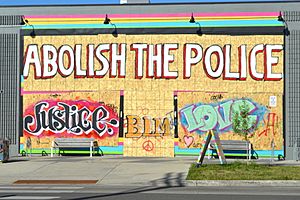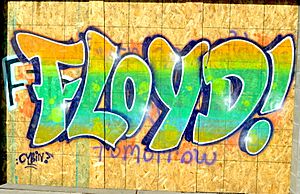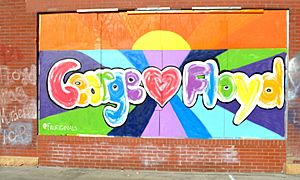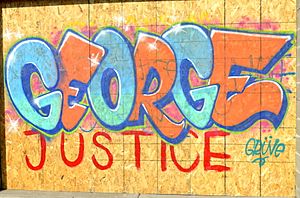Save the Boards facts for kids
| Formation | 2020 |
|---|---|
| Type | Nonprofit |
| Location |
|
| Origins | Aftermath of protests over the murder of George Floyd |
| Website | Official website: https://www.savetheboards.org/ |
Save the Boards is a special group in Minneapolis, USA. They are a nonprofit organization, which means they work to help people and don't make money for themselves. Their main job is to collect and save amazing street art. This art appeared on wooden boards during the big protests in 2020, after a sad event involving George Floyd.
Contents
Why Save the Boards Started
On May 25, 2020, George Floyd, a Black man, died while being arrested by a police officer in Minneapolis. This tragic event led to many large protests across the country. People wanted the officers involved to be held responsible.
During these protests, many buildings put up wooden boards over their windows and doors. This was to protect them from damage. But these boards quickly became giant canvases for artists and protesters. People used them to share their feelings and tell stories through art. The boards showed messages about what happened and honored George Floyd. They also remembered other Black people who had died in similar ways, like Ahmaud Arbery and Breonna Taylor.
As the protests became less frequent, many of these artworks were left outside. They were exposed to the weather and could have been lost. The Black Lives Matter movement has been around since 2013. However, the protests in 2020 were much larger than anything seen before. Millions of people in the United States took part. Art has always been a part of the Black Lives Matter movement. Save the Boards wanted to collect and save the art from Minneapolis. They hoped these boards would help people heal, learn, and think about what happened.
How Save the Boards Began
Save the Boards started because of Kenda Zellner-Smith. She was 24 years old and from Minneapolis. As an African American woman, Kenda felt it was important to save the plywood art. This art showed how the community felt after the death of George Floyd.
Kenda had just finished college. She asked her roommate and friend, Emma Shepherd, to help. Kenda didn't know much about saving art or organizing groups at first. But she worked hard to get the community's support. Together, they collected and saved more than 800 plywood boards from the protests.
Kenda Zellner-Smith also teamed up with Leesa Kelly. Leesa is the founder of another group called Memorialize the Movement. This group also started on May 25, 2020. They also wanted to save the plywood murals because they were a form of protest. With donations from the community, Kenda and Leesa rented trucks and storage units. This allowed them to collect and care for the boards. Kenda Zellner-Smith explained that saving the murals was a way for her to cope. It helped her deal with the difficult reality she was living in.
What Save the Boards Does
Their Goals and Future Plans
Save the Boards does more than just collect plywood. Kenda Zellner-Smith says their main goal is to create a "long-term multi-media" record of the boards and murals. This will serve as a reminder of the community's efforts to heal and learn after the tragedy.
To do this, the organizers are taking photos of the boards. They are creating a digital collection with the University of St. Thomas in St. Paul. Students are also writing down information about the artists, where the art was found, and when it was made.
Kenda Zellner-Smith plans to show the boards in different places. These include exhibitions, community events, workshops, and speaking events. This will help people talk and think about the art's importance. The art tells a story of resistance against violence. By displaying the boards for a long time, they will continue to share the story of the 2020 protests in Minneapolis.
Working with the Community
Save the Boards has collected over 1,000 plywood murals. They have also organized art events and workshops. These events help to highlight Black, Indigenous, and People of Color (BIPOC) in art preservation. They have worked with art experts like the Midwest Conservation Center. The center said most pieces are in great shape and will last for years with proper care.
In February 2021, Save the Boards worked with Memorialize the Movement. They also partnered with the Minnesota African American Heritage Museum and Gallery (MAAHMG). The Hennepin County Library sponsored a community discussion. It was about a free outdoor art exhibit planned for May 2021 at Phelps Park in Minneapolis. The founders, Leesa Kelly and Kenda Zellner-Smith, explained why saving these artworks is important to the Black community.
The May 2021 exhibit was called "Justice for George: Messages from the People." It showed the plywood art murals from 2020. It also featured new art being painted live. Grants from the Metropolitan Regional Arts Council (MRAC) and the Minnesota Vikings helped fund the event. Kenda Zellner-Smith said that Save the Boards received a huge amount of support from the community.
Artists and Their Messages
Save the Boards believes it's important to act quickly to raise awareness about issues with policing. They think art is a powerful way to start difficult conversations during times of social unrest. Leesa Kelly, from Memorialize the Movement, said that the story needs to be told in a way people will understand. But it should not make them too comfortable.
Save the Boards also points out that museums sometimes struggle to show stories from marginalized groups fairly. Because of this, the organization says it will not act like a traditional museum. They will actively work to avoid bias when collecting art. Since they collect street art that might not have a clear owner, Save the Boards also respects the artists. They say that any Black creators of the pieces can come forward. They can "retouch, reclaim, sell, keep, discard, showcase etc." their work whenever they want.
The Importance of Street Art
About 2,700 pieces of street art appeared around the world after George Floyd's death. This art was seen from the site of his death in Minneapolis to places as far away as Syria. In Minneapolis, at the spot where Floyd was arrested, three artists helped create one of the many plywood murals. These artists were Greta McLain, Xena Goldman, and Cadex Herrera. The mural showed a portrait of Floyd with a sunflower behind him. Cadex Herrera, who is an educator, felt he needed to contribute after Floyd's death. McLain said that art helped the community heal. She explained, "Art is therapy. Art can say things you cannot express with words. It brings the community together to reflect, to grieve, for strength and for support."
Street art, especially murals, has a long history in protests. It has often been used to inspire change, build communities, and help people remember important events. Even in Syria, artist Aziz Asmar created art protesting George Floyd's death. He shared a similar feeling, saying, "Drawing is a world language everyone can understand. We are all brothers around the world, and we just want peace."
The Save the Boards group works to preserve these plywood boards. They were created by artists like McLain and Asmar. The organization believes that by collecting, documenting, and sharing this art back with the Minneapolis community, it can continue to tell a visual story. It serves as a reminder of the community's strength. The preserved boards "do not belong to anyone, person or business." Instead, they are meant to be a shared gift of healing and unity for everyone.
See also





